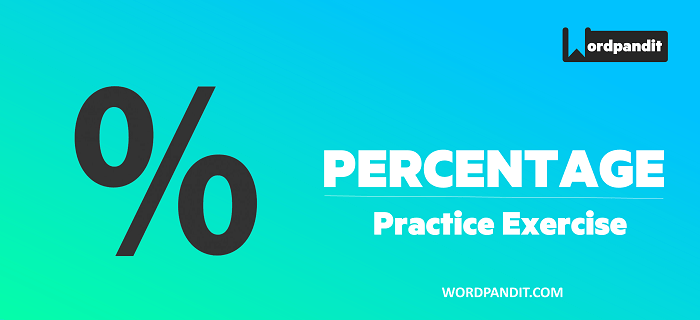Percentages: Practice Exercise-1
Question 1: The price of sugar having gone down by 10%, a consumer can buy 5 kg more sugar for Rs 270.
The difference between the original and reduced price per kg is
(a) 62 paise
(b) 60 paise
(c) 75 paise
(d) 53 paise
Answers and Explanations
Solution: (b)
Reduced price => Rp/100y per kg
R = Rs 270 , p=10% ,y=5kg
{(270×10)/(100×5)} = Rs. 5.4
Original prices per kg= Rp/(100-p)y per kg
{(270 x 10)/ (100 – 10)5} = 2700/450 = Rs. 6
Difference will be = 6-5.4= Rs 0.6 = 60 paise
Alternate Method:
Let the original price of sugar be Rs. p.
Then, reduced price of sugar
{p-(10p/100)} = 90p/100 = Rs. 9p/10
Expenditure on any quantity = price × total consumed qty
Total Consumed Quantity = Expenditure on any quantity/price
Now, according to the question,
{270/(9p/10)- (270/p)} = 5
=> {(270 x 10)/9p} – (270/p) = 5
=> {(300/p) – (270/p)} = 5
=> {(300 – 270)/p} = 5
=> p = 30/5 = 6
∴ Original price of sugar = Rs. 6
Reduced price of sugar
(9 x p)/ 10 = (9 x 6)/10 = Rs. 5.40
∴ Required difference = (6 –5.40)= Rs. 0.60 or 60 paise
Question 2: A reduction of 10% in the price of wheat enables a man to buy 50 g of wheat
more for a rupee. How much wheat could originally be had for a rupee?
(a) 400g
(b) 500g
(c) 450g
(d) 350g
Answers and Explanations
Original prices per kg= Rp/(100-p)y per kg
{(1 x 10)/(100 – 10)0.05} = Rs. 20/9 /kg
It means the man can buy 1 kg or 1000 gm in Rs 20/9 or he can buy
(1000 x 9)/20 = 450g in one rupee.
Alternate Method:
Original price of wheat = Rx x/kg
New price = Rs. 9p/10 per kg
Expenditure on any quantity = price per qty × total consumed qty
Total Consumed Quantity = (Expenditure on any quantity)/ (price per quantity)
According to the question,
{1/(9p / 10)} – 1/p = 50/1000
{(10/9p) – (1/p)} = 50/1000
(10/9p) – (1/p) = 1/20
9p = 20
p=20/9
Original Price = Rs. 20/9 per kg
=> Rs. 20/9 = 1000g
=> Rs. 1 = (1000 x 9)/25 = 450 g
Question 3: An ore contains 25% of an alloy that has 90% iron. Other than this, in the remaining 75% of the ore, there is no iron. To obtain 60kg of pure iron, the quantity of the ore needed, (in kg) is approximately
(a) 250.57 kg
(b) 266.67 kg
(c) 275.23 kg
(d) 300 kg
Answers and Explanations
Solution: (b)
In 1 kg of ore, the iron = (90/100) x (25/100) x 1000 = 225 gms
Hence for 225 gm iron, the ore required = 1 kg
So, to get 60 kg of iron, the ore required = (1/0.225) x 60 = 266.67 kg
Question 4: 75 g of sugar solution has 30% sugar in it. Then, the quantity of sugar that should be added to the solution to make the quantity of the sugar 70% in the solution, is
(a) 125 g
(b) 100 g
(c) 120 g
(d) 130 g
Answers and Explanations
Solution: (b)
Sugar in original solution = (75 x 30) / 100 = 22.5 g
Let x g of sugar be mixed
According to the question
{(22.5 + p)/(75 + p)} x 100 = 70
⇒ 2250 + 100p = 75 × 70 + 70p
⇒ 2250 + 100p = 5250 + 70p
⇒ 30p = 5250 – 2250= 3000
=> p = 3000/30 = 100g
Percentages: The Complete Lesson
Table of Contents
Tests

